It’s usually in the absolute worst of times that we see parts of humanity shine. During difficult challenges, we’ve seen love at work. Take, for example, the millions of people who are staying home to “flatten the curve” of illness that has invaded our society. Another example would be those who work tirelessly to ensure our health and welfare, as well as those who stock shelves and deliver packages.

(Photo courtesy of Genevieve Jezick and Kirk Larsen)
Still another example would be Joann Fabrics of Westbury, which has offered sewing kits to the creative public, with already cut-out patterns for masks. The completed masks are returned to the store and redistributed to places in need. These are the unsung heroes of this crisis. This is love at work.
Another shining example of love incarnate can be found right here in Hicksville, by two Hicksville High School (HHS) alums, Kirk Larsen and Genevieve Jezick. Larsen, who has served as guest teacher at HHS and Jezick, who teaches a pattern-making class at Parsons School of Design in Manhattan, happened upon the same brainstorm simultaneously: they identified the dire need of healthcare workers for masks and put forth a plan to make them. While they were certain that they could produce a makeshift mask, they weren’t certain about where to deliver them.
While they began to research multiple patterns online, Jezick recalled the facility where her parents once received care. She made a call to the director at Huntington Hills Center for Health & Rehabilitation in Melville, who responded, “This is the best news I’ve heard all week.” The dynamic duo had someone to accept the masks. Now, they needed to figure out a pattern with the greatest amount of protection.
While Larsen researched the technical needs regarding fabric and filtration rate, Jezick found an online pattern and began to work on a prototype. The mask could fit a child or a small woman but could not fit a larger person. They began to tweak and modify the design but found the pattern took a long time. If they were going to mass produce, they would need something that they could knock out faster.
According to Larsen, “On the first night, we worked on some prototypes. The following morning, we began to revise the patterns. By the end of the second day, we had created 57 masks.”
By Day Three, Larsen and Jezick delivered 45 completed masks to Huntington Hills, all of which were laundered and sanitized at the facility.
The pair received excellent feedback from the rehabilitation center. After reaching out to neighbors who were also members of the healthcare field, they worked to update their research. Their searching led Larsen to the “Relief Crafters” link, which helped them find a pattern that would fit more personnel. The pattern, known as the Olson (N95) mask, had multiple sizes which made the pattern a lot more universal. A demonstration video, put together by UnityPoint Health of Cedar Rapids in Iowa, helped Larsen and Jezick create a mask that employed pipe cleaners at the bridge of the nose to ensure better closure as well as a place to accept a HEPA filter. They revised, made more prototypes and started to produce the new masks immediately.
The masks, Larsen stressed, are not intended for use in the hospital due to infection control practices. He and Jezick shared some masks with nurses to be worn to work. There is a strict protocol to be followed with the masks related to appropriate disinfection, which must be adhered to in order to prevent passing microbes from patient to patient. Larsen and Jezick’s masks are made from a tight-weave cotton, which is similar to quilter’s fabric. They are washable in hot water and can stand up to ironing, but they can also be placed in a 200-degree Fahrenheit oven for 20 minutes to kill viruses and bacteria. Presently, Larsen and Jezick are using two home sewing machines as well as two Serger overlock machines to create their beautiful masks.

(Photo courtesy of Genevieve Jezick and Kirk Larsen)
While they continue to make masks mainly for medical staff, first responders and nurses, they stressed the importance of using the masks outside of the clinical setting. They are conscious that the needs of the medical community have important criteria to follow. They will be making more masks for those facilities with the greatest need. As Larsen explained, “We are making these because we can. It’s our way to help. It’s the best we can do to fill in the voids for now.”
It is their greatest hope that the need for these masks will become obsolete over the next few weeks.
Larsen and Jezick use a little quote on their Facebook and Instagram pages, regarding the creation of masks for the healthcare community: “What we’re doing is a drop in the bucket. When the bucket is empty, every drop helps.”
Truer words were never spoken.
If you would like to help, visit Kirk Larsen and/or Genevieve Jezick on their Facebook page, where you can find the pattern for the Olson mask. If each of us helps in a crisis, it’s no longer a crisis but a beautiful symphony of love for the world and for each other.





























